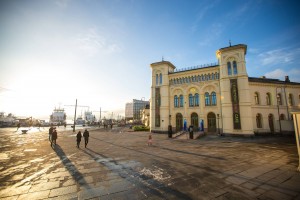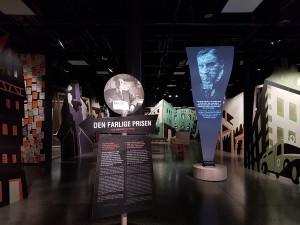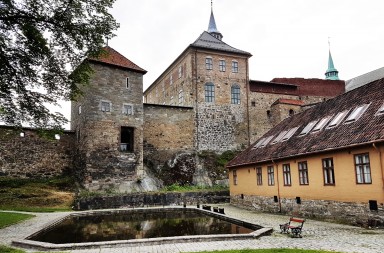Ever wondered why the Nobel Peace Prize is given by a Norwegian Committee in Oslo and not in the Swedish capital like the other Nobel awards? TheOsloBook together with the Oslo Guidebureau invite you to take a closer look at the Nobel Peace Center, and the fascinating history behind the Nobel Peace Prize being awarded in Oslo.
The Nobel Peace Prize is defined as the “world’s most prestigious prize” in the Oxford Dictionary. According to Alfred Nobel’s will, the prize has been awarded in Oslo ever since its beginning in 1901, while the other four prizes are handled by Swedish committees. Nobel left no explanation as to why the prize for peace was to be awarded in Oslo, but there are several theories about this.
Oslo’s Nobel Peace Center
In November 2000, the Norwegian parliament decided to ask the government, in collaboration with the Nobel Committee, to establish a peace prize centre in the old railway station “Vestbanen”. One of the main reasons for this was to be able to show guests from all over the world the history of the prize, tell the story of Nobel’s life, and present the laureates and their work. Through permanent and temporary exhibitions, guided tours, various events and family activities, the centre’s main aim is to foster reflection and engagement on topics related to war, peace and conflict resolution.

The Nobel Peace Center is situated on the City Hall Square in Oslo, on the harbour front. Photo: Johannes Granseth / Nobel Peace Center
The permanent exhibitions tell the story of Alfred Nobel, the Nobel Peace Prize, and the laureates. After having passed through the reception and gift shop, the golden Passage of Honour gives visitors a short introduction to this year’s Nobel Peace Prize winner. On the second level of the centre guests will find The Nobel Field, often named “the heart of the Nobel Peace Center”. In a type of garden, all laureates are presented on their own screen like flowers, surrounded by thousands of small lights. The designer David Small’s primary focus in the room was the ambience, not the technology. Visitors meet the Peace Prize laureates from today and going back more than a century—all in the same room.

The Nobel Field, often named “the heart of the Nobel Peace Center”. In a type of garden, all laureates are presented on their own screen like flowers, surrounded by thousands of small lights.
In The Nobel Chamber on the second level, visitors will find the magic book about Alfred Nobel’s fascinating life. Here, his experiences and inventions come to life. The book is in itself an adventure and provides guests with a reading session very much out of the ordinary.
Finally, The Wall Papers are filled with information, photos, texts, videos and animations surrounding the Peace Prize laureates’ life and work. On five large screens, guests may navigate through facts about the prize, the laureates, and the Nobel system.
Alfred Nobel’s Will: Why Norway?
When Alfred Nobel died on 10 December 1896, it was discovered that he had left a will, according to which most of his vast wealth was to be used for five prizes, including one for peace. The will stated that the peace prize was to be awarded in Norway without any further explanation. A reason for his choice might have been that Norway at this point was still in a union with Sweden, and also well known for its strong interest in peaceful solutions of international disputes in the 1890s. Alfred Nobel might have had the opinion that it would only be natural for the smaller union partner to also be responsible for one of the prizes. He might have chosen the peace prize because, due to the union, Norway did not have its own ministry of foreign affairs. The Swedish politicians were responsible for Norway’s foreign affairs as well. Possibly Nobel thought that it was especially important for the peace prize not to be mixed up with a country’s politics. Furthermore, Nobel may also have been influenced by his admiration for Norwegian fiction, particularly by the author Bjørnstjerne Bjørnson. But Nobel never told anyone about the background for his decision. It may very well have been a different reason or a combination of all these factors.
There are more than 300 peace prizes in the world. None is in any way as well known and as highly respected as the Nobel Peace Prize.

Get a peace prize medal for yourself. A chocolate one at the Alfred cafe.

The pastry in the Alfred cafe is really tasty!
The Dangerous Prize: visit the exhibition devoted to one of history’s most important whistle-blowers
At the time, the award of the Nobel Peace Prize for 1935 to German journalist and editor Carl von Ossietzky was one of the most controversial in the award’s history. Yet it was to prove one of the Nobel Committee’s most important—and correct—decisions. The Peace Prize that was announced 80 years ago, one year in arrears, went to a fearless pacifist who had published details of Germany’s unlawful rearmament in the years before World War II.
The Nobel Peace Center’s exhibition The Dangerous Prize goes behind the scenes to throw new light on Ossietzky’s life, the campaign to nominate him for the award and the Nobel Committee’s deliberations. In collaboration with the University of Oldenburg and the Norwegian Nobel Institute, the Nobel Peace Center have brought together original documents, the Peace Prize diploma, and Nobel medal that Ossietzky himself was never able to accept. He was hospitalised with tuberculosis, a disease he had contracted during his internment in a Nazi concentration camp.

The Dangerous Prize exhibition opened on 9 June 2016 and will last until February 2017.
Watch the Nobel Peace Prize Ceremony on TV!
See the home of the Nobel Peace Prize Ceremony first hand! The award ceremony takes place in Oslo City Hall every year on the 10th December. The city hall is open for visitors every day from 09:00–16:00 unless a special event is taking place. Entrance is free and you can stand in the same hall where famous laureates like Kofi Annan (2001) and Barack Obama (2009) gave their lectures.
Tickets:
ADULT: 100 NOK
STUDENT/SENIOR: 65 NOK
FAMILY TICKET: 180 NOK
CHILDREN UNDER 16: free
How to Get to the Nobel Peace Center?
The Nobel Peace Center is located in the old Western Railway station, next to City Hall and the harbour area Aker Brygge.
Bus stop: Rådhuset, 2-minute walk from Oslo City Hall (Rådhuset).
Tram stop: Aker Brygge, 2 minutes away from the Center.
Metro stop: Nationalteatret, with a five-minute walk.
If you wish to learn more about Oslo, book a professional guide at Oslo Guidebureau:
Phone: +4722422818 / Mail: info@osloguide.no
Text: Stefanie Tuma / Photos&Videos: Dina Johnsen



